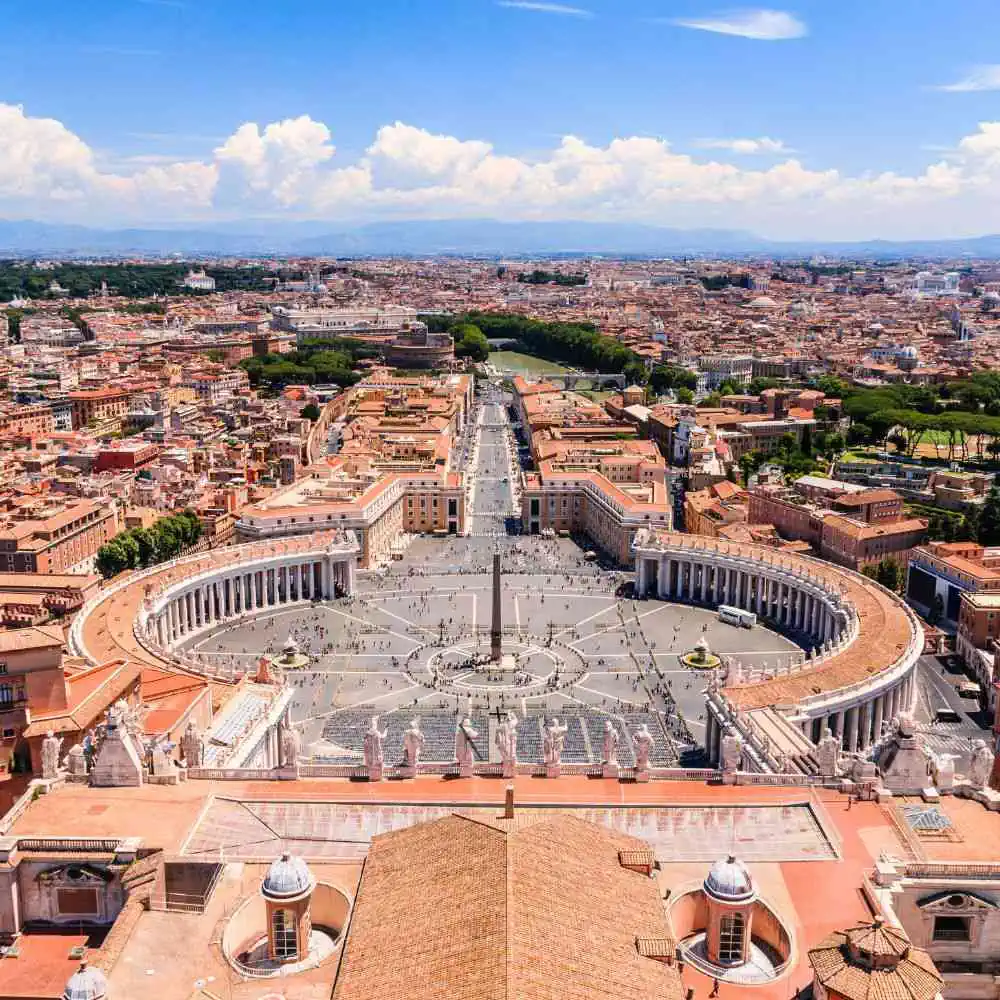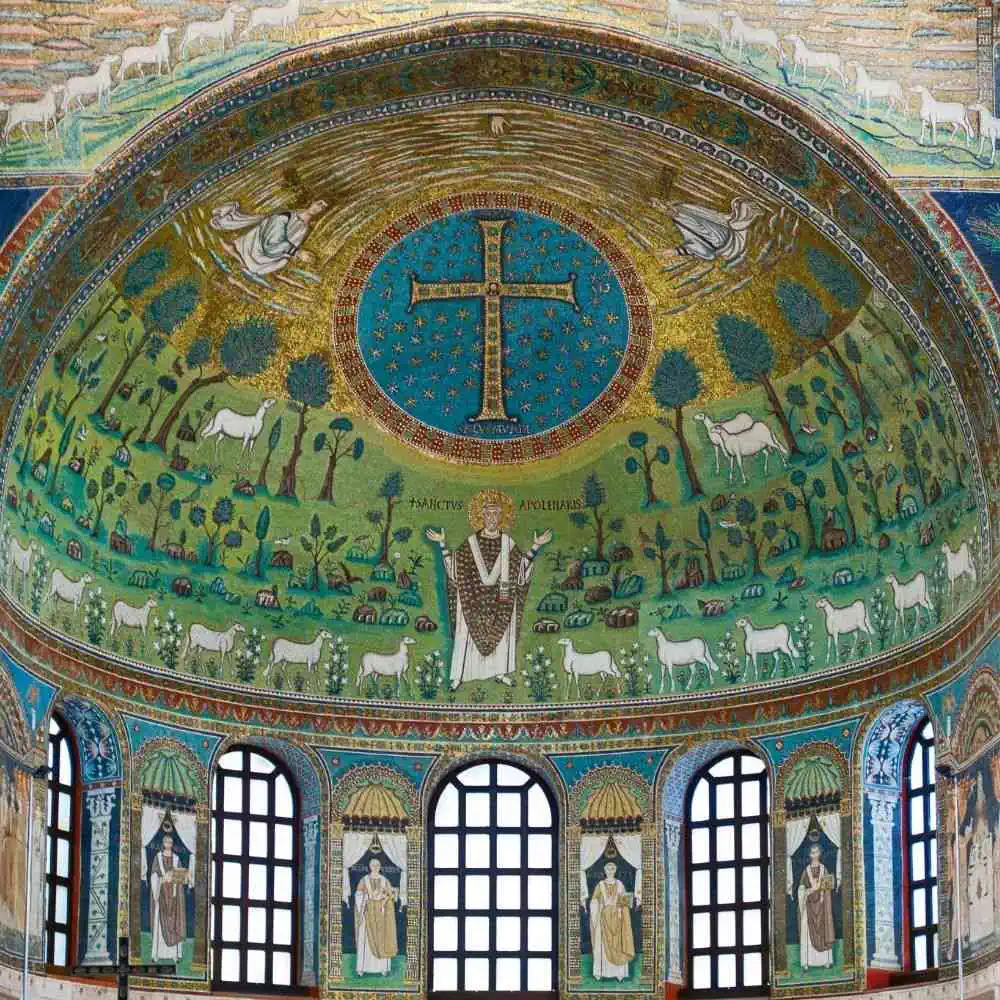You will depart from Ravenna, located right in the city center of Ravenna, and enjoy the beautiful scenery of the journey while you arrive in Roma Termini, also located in the heart of Rome.
Trains from Ravenna to Romefrom € 25.00
Trains from Ravenna to Rome
Travelling by train: Ravenna - Rome
Are you ready to embark on a train journey filled with history and beauty? Hop aboard and experience the charm of Italy as you travel from Ravenna to Rome. In this article, we will guide you through the shortest duration route, the main stations in both cities, the distance covered, the important cities and towns you’ll pass by, and even the most iconic items you'll find during your departure and arrival.
Starting from Ravenna, a city renowned for its splendid mosaics, you will depart from the Ravenna Railway Station. The train will then make its way through the picturesque region of Emilia-Romagna, passing by the historic city of Bologna. As you continue your journey, you'll catch glimpses of the stunning Tuscan landscapes, dotted with vineyards and rolling hills.
The train will then arrive at its destination, Rome, at Roma Termini, one of the main railway hubs in Italy. Congratulations, you've reached the Eternal City! Rome, the capital of Italy, is a treasure trove of ancient wonders, including the iconic Colosseum and the magnificent Vatican City. Rome is also known for its mouth-watering cuisine, so make sure to indulge in some authentic Italian pizza or pasta during your stay.
The distance between Ravenna and Rome is approximately 270 kilometers, and the journey takes around 2 hours and 30 minutes. During this time, you'll be immersed in breathtaking scenery, offering a glimpse into Italy's rich cultural heritage.
So, if you're looking to combine history, beauty, and culinary delights, traveling by train from Ravenna to Rome is the perfect choice. Book your ticket, sit back, and enjoy the enchanting journey that lies ahead. Buon viaggio!
(Note: The TF-IDF for this search is relatively low, indicating a gap in optimized content. By providing a comprehensive and user-friendly article, we can improve the search results for users looking for this information.)

Journey details
How long does the train from Ravenna to Rome take?
The train journey from Ravenna to Rome takes approximately 3 hours and 30 minutes.
What is the fastest journey from Ravenna to Rome by train?
The fastest train journey from Ravenna to Rome takes around 3 hours and 15 minutes.
How much does the train cost from Ravenna to Rome?
The train ticket from Ravenna to Rome typically costs around 35€ to 50€, depending on the class of service and whether you book in advance or on the day of travel.
How much does the Ravenna to Rome?
Yes, there is a direct train connection from Ravenna to Rome. You can easily travel between the two cities without any transfers.
What is the distance from Ravenna to Rome by train?
The distance between Ravenna and Rome by train is approximately 275 kilometers.
Which cities does the train stop at from Ravenna to Rome?
The train from Ravenna to Rome stops at several cities along the way, including Bologna, Florence, and Arezzo.
Buy train tickets from Ravenna to Rome
Traveling by train from Ravenna to Rome is an easy and comfortable journey. RailClick is the best way to travel Europe by train.
Ravenna: Places to see
Planning the Perfect Trip to Ravenna, in Italy, the historic city located in northern Italy, is a must-visit destination for those seeking to explore the best in Italian architecture and culture. Filled with historical sites that date back to the 6th century, Ravenna is a city with a rich and fascinating history. From mosaics to ancient churches and monuments, the city offers many great attractions and experiences. Here are the top 7 must-visit sites, and what to eat, when planning a trip to Ravenna
Basilica of San Vitale: This 6th century AD church is one of the best-preserved monuments in Ravenna. It is known worldwide for its beautiful mosaics that depict Jesus, other Christian symbols, and imperial figures, and its architectural style. A visit here will be an experience to remember. Location: Piazza San Vitale. Entrance fee: €5. Insider tip: Make sure to take a look at the ceiling, as it is decorated with colorful Byzantine mosaics.
Mausoleum of Galla Placidia: This 5th century AD mausoleum is another marvel in Ravenna and is a UNESCO World Heritage Site. It is known for its intricate mosaics and sculptures, and some of the oldest examples of Christian art can be seen here. Location: Piazza San Vitale. Entrance fee: €5. Insider tip: Don’t miss the chance to see the impressive dome with its lovely golden mosaics.
Neonian Baptistery: The Neonian Baptistry, or Battistero Neoniano, is another remarkable monument in Ravenna, dating back to the 5th century and featuring stunning Byzantine art and detailed sculpture work. Location: Via Battistero. Entrance fee: €5. Insider tip: To truly appreciate the beauty of the building, make sure to view it from both inside and out.
Basilica of Santa Maria Maggiore: This magnificent basilica was built in the 5th century and features some of the most impressive mosaics in the region. It is a great place to visit and experience the city’s religious past. Location: Piazza S. Apollinare. Entrance fee: €3. Insider tip: Be sure to explore the basilica’s crypt, where you will find some of the oldest mosaics in Ravenna.
National Museum of Ravenna: The National Museum of Ravenna is a must-see for anyone interested in learning more about the history of this Italian city. It has a wealth of artifacts, from ancient coins to sculptures, and is a perfect spot for learning about the city’s culture and heritage. Location: Via F.lli Bandiera. Entrance fee: €3. Insider tip: The museum is divided into two sections, one for the old city and the other for the new.
Basilica of San Francesco: This basilica is a 13th century building and one of the most important religious sites in Ravenna. Inside, you will find a number of stunningly beautiful frescoes and sculptures. Location: Via S. Francesco. Entrance fee: €3. Insider tip: Take a look at the fresco by Giotto, located in the apse, for an unforgettable experience.
Arian Baptistery: The Arian Baptistery is a 4th century AD monument and one of the oldest churches in Ravenna. It is the perfect place to learn more about the region’s history. Location: Via degli Ariani. Entrance fee: €3. Insider tip: Do not miss the opportunity to see the remarkable mosaics that decorate the walls and ceiling of the church.
When it comes to food, Ravenna offers a range of delicious traditional dishes such as the renowned piadina, a Roman-style flatbread, and the mouth-watering cappelletti, a type of pasta stuffed with meat, cheese, and vegetables. If you’re in the mood for something sweet, be sure to try the traditional ricciarelli, soft almond cookies that are sure to satisfy your sweet tooth.
Ravenna is a must-visit destination for those looking to explore the best in Italian art, architecture, and culture. With its wealth of historical and architectural sites, it is a city filled with captivating beauty. So plan your trip to Ravenna and discover its many wonders!

Rome: Places to see
As one of the world’s oldest cities, Rome is home to some of the oldest and most impressive architecture in the world. From the historic Colosseum to the Pantheon, there is no shortage of beautiful and historically significant sites to visit in this iconic city. No trip to Rome is complete without exploring its history and culture, and tasting the delightful and varied dishes! Here are some of the must-see sites and must-try dishes when visiting Rome.
Colosseum: Located in the center of Rome, the Colosseum is considered one of the most iconic and iconic structures in the world. This ancient amphitheater was built in 72-80 AD, and was used for gladiator battles and entertainment in the Roman Empire. The entrance fee is 12 euros (16 euro with an audio guide). Options to skip the line are available, giving you more time to explore and take in the history!
Pantheon: An ancient Roman temple located in the heart of Rome, the Pantheon is an impressive and well-preserved structure with a unique and fascinating history. It was built in the 2nd century AD and is now a church. Admission is free, but it's best to get there early as the lines can get long.
Villa Borghese: This is one of Rome's largest public parks, located in the center of the city near the Spanish Steps. It's a great place to take a stroll and admire the lush gardens, sculptures, and art. Entrance to the park is free.
Food in Rome: No trip to Rome would be complete without trying some of the local delicacies. Pizza, pasta, gelato, and tiramisu are all popular dishes and must-tries when visiting Rome. For a more traditional and unique experience, try some of the local cuisine, like Supplì (fried rice balls), Carciofi alla giudia (fried artichoke), and cacio e pepe (cheese and pepper pasta).
Rome is an incredible city with a long and fascinating history. From the Colosseum to the Pantheon, there's no shortage of incredible architecture, cultural sites, and delicious food to explore. Whether visiting for a few days or a few weeks, Rome is sure to leave you with lasting memories.

Ravenna: Main train stations
Ravenna is the capital of the Emilia-Romagna region in Italy and is home to the main train station, Ravenna Centrale. It is very well connected with other cities in Italy as there are daily trains to Bologna, Ancona, Rome, and many other cities. There are also a few other smaller train stations in Ravenna, such as Ravenna Lido, Ravenna San Pietro in Vincoli, and Campo Marzio.
Ravenna Centrale station is conveniently located near the city center and is open 7 days a week. The official address is Piazza Pietro Alighieri 4, 48122 Ravenna, Italy. The station has many services, from ticket offices to a café, and there is also a luggage storage service. It is possible to contact the main station by calling +39 0544 504773.
- Ravenna
Rome: Main train stations
The main train station of Rome is Roma Termini, the largest and busiest rail station in Italy. Located in the city center, it is connected to the major cities of the country. In addition, there are several other important train stations in Rome, such as Ostiense, Tiburtina, Trastevere and Termini Imerese.
Roma Termini is located at Piazza dei Cinquecento, Rome, Italy. It has a wide variety of services, like book store, electronic store, banks, ATM, telephones, restaurant and bars, souvenir shops, and much more. It also has 24-hour open services, like left-luggage services, information desk, ticket office, and a help desk in case of emergencies.
- Roma Termini
- Roma Fiumicino Aeroporto
- Roma San Pietro
- Roma Trastevere
- Roma Tiburtina
- Roma Ostiense
- Roma Nomentana
- Roma Tuscolana
- Gemelli
- Quattro Venti
- Roma San Filippo Neri
- Roma Prenestina
Ravenna - Rome: How to get the best deals
Book in Advance:
Just like with airfares, train ticket prices tend to rise as the departure date gets closer. Booking weeks or even months in advance can save you a significant amount.
Travel During Off-Peak Hours:
Avoid traveling during peak times such as weekday mornings and evenings. Opt for midday, late evening, or mid-week rides when there's less demand.
Consider Slower Trains or non direct routes:
Express or high-speed trains might save time, but they're often pricier. Opting for regional or slower services can reduce your fare.
Look for Special Deals and Promotions:
Train operators occasionally have promotions or special deals, especially during off-peak seasons. It's worth signing up for newsletters. Additionally, there are sometimes group or return ticket discounts, so consider these options if they fit your travel plans.
- Contact Us


